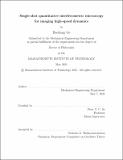Single-shot quantitative interferometric microscopy for imaging high-speed dynamics
Author(s)
Ge, Baoliang
DownloadThesis PDF (7.283Mb)
Advisor
So, Peter T. C.
Terms of use
Metadata
Show full item recordAbstract
The observations of millisecond, micrometer-scale dynamical events are essential, especially in cell biology investigations, material science studies and the development of next-generation clinical diagnosis methods. For imaging these high-speed dynamics, we need optical microscopy methods having millisecond temporal resolution, submicron spatial resolution and the capability of quantitative imaging. However, current imaging techniques usually either could only offer qualitative imaging, or has low quantitative imaging speed due to the requirement of multiple measurements or scanning. Therefore, high-speed quantitative optical imaging techniques that could provide satisfactory imaging performance for the observations of millisecond, micrometerscale dynamical events are still highly demanded.
In my PhD work, several single-shot quantitative imaging techniques are proposed based on off-axis interferomertic microscopy, to overcome limitations of current imaging techniques, driven by different specific motivations in biomedical researches and material inspections. Firstly, I presented the novel technique of single-shot quantitative amplitude and phase microscopy, which is motivated by the requirement of fast quantitative imaging of RBCs for the clinical diagnosis and drug screening of many diseases, such as malaria and sickle cell disease. Taking advantage of quantitative interferometric microscopy along with the engineering of the medium’s optical properties, we realized the simultaneous measurements of RBCs’ morphological, molecular and mechanical properties. The second novel imaging technique is for studying novel aniostropic materials (i.e., lyotropic chromonic liquid crystals (LCLCs)), especially the rheology of them, which needs the fast quantitative mapping of polarization parameters (i.e. retardance and orientation angle) of the light field transmitting through anisotropic materials. The polarization sensitive microscope is combined with off-axis shearing interferometry, realizing the single-shot quantitative imaging of LCLC flow with an imaging speed of over 500 frame per second (fps) for the first time. Finally, deep-learning single-shot optical diffraction tomography (DS-ODT), is proposed that fully exploits the potential of off-axis interferometric microscope, to push the imaging speed of 3D cell imaging. By illuminating the cell with four angles simultaneously, 3 and using innovative deep learning approach to extract the prior knowledge from a training dataset of ⇠ 900 NIH/3T3 cells, we realized single-shot 3D cell imaging at a 3D imaging speed of over 10,000 fps, enhancing the throughput of 3D flow cytometer to over 5000 cells per second.
These technology advances open the horizons in which the single-shot quantitative interferometric microscopes could serve as powerful platforms in biological cell characterizations and anisotropic material (liquid crystals) inspections, benefiting from their unprecedented quantitative imaging speed. Furthermore, due to the increasingly needs for studying high-speed dynamics and developing novel microfluidic devices and cell characterizing methods, we can envision these techniques could find an even wider range of applications in biology, material science and clinical diagnosis.
Date issued
2021-06Department
Massachusetts Institute of Technology. Department of Mechanical EngineeringPublisher
Massachusetts Institute of Technology